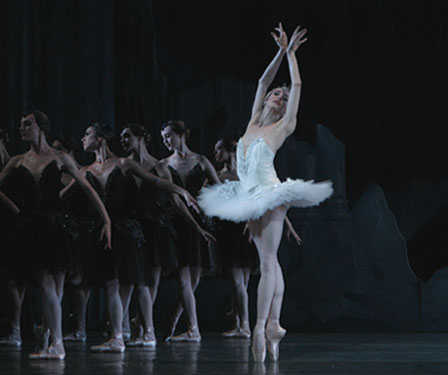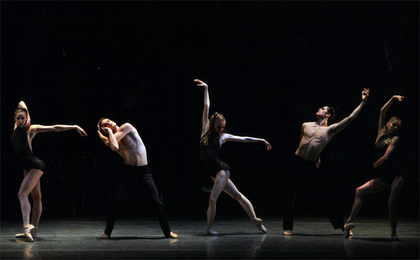foot in mouth: February 2009 Archives
Earlier this season, worrying over the first-time Balanchine audience drawn by the $25 orchestra seats at New York City Ballet, I warned against the Short Stories program. My thinking: though Balanchine's genius for unleashing the comedy in such recognizable genres as the tale of a toy animated by real feelings or the twisty gangster thriller runs through "The Steadfast Tin Soldier" and "Slaughter on Tenth Avenue," the ballets don't make you fall into the trance of the dance the way many of his plotless ballets do, and they don't have the tragedy--sublimated and so complete, there's no point even crying--that mark his greatest works. But I wasn't thinking of "Swan Lake."
If you have ever loved "Swan Lake" or thought, listening to the Tchaikovsky score, that you might, run to catch Balanchine's one-act.
Which act, you ask? Strictly speaking, the two by the lake, where Odette and Siegfried meet, then lose each other. But Balanchine kaleidoscopes the whole story, all its tragedy and hope, into those two acts.
He honors traditional storytelling--preserving much of the original choreography for the swan queen--and at the same time reveals the story's contours. At one point Siegfried spins Odette around and around in a deep attitude penché. She is a bird diving downward and also a figure become a state of things. We've entered the terrain of Yeats's widening gyre, in which "innocence is drowned."
More than with Odette, Balanchine takes liberties with the swans. Thanks to a performance Saturday full of feeling and vivid detail (special kudos to Dena Abergel), the corps patterns were a revelation.
In all black for their doom, the swan-women echo Odette's movements of arms and wrists--for example, the broken wrist on an arm hugging the neck to sketch a span of wing that cuts both horizontally and vertically, that should pronounce freedom but instead signals imprisonment (the swan ladies may be able to fly, but it won't help them escape their bird form).
The women also embody the turbulence of the first night, when the hunter endangers them, then promises to save them, and the last night, when he betrays them and the lake of tears swells. Balanchine keeps the corps in constant motion--the large and small circles a bow to the serpentine lines of the original choreographer, Lev Ivanov.
I've never seen a "Swan Lake" before that allows itself such departures from the original steps only to arrive at the center of the story.

There will be three more performances of Short Stories, all next week: Tuesday Feb 24, Wednesday Feb 25, and Friday Feb 27. If you call on Monday the 23rd at 10 am, you have a shot at the $25 tickets. The casts are different from what I saw February 14. As Odette, Wendy Whelan (pictured above) seemed to me sublime for long stretches but occasionally too quiet in her effects. Others have felt she was more one or the other. Both of the new casts are promising--Sara Mearns because she's almost always captivating and Maria Kowroski because she is when she's dancing regal adagio roles.
Photo by Paul Kolnik for the New York City Ballet
UPDATE April 6: Tonya Plank, who saw the same performance of "Swan Lake" I did (we were sitting next to each other--very fun!) argues, compellingly, that the Balanchine version eviscerates the drama in its focus so exclusively on Odette's plight: Siegfried's fraught internal dilemma is cast aside. As she declares, "I am a Nureyevian when it comes to Swan Lake." I kinda am, too. But it seemed to me Balanchine was successful in extracting the spirit of the story from its particular conditions--always a dangerous operation, because you can end up, as Tonya feels he did, with ballet cliches. Anyway, go here for her persuasive post.
I was just going to write about the lost heads and clichéd eyes of our women ballet dancers when The New Yorker's Joan Acocella came out with a Critic's Notebook, "All Smiles," that begins,
An epidemic of flirtiness has attacked our ballet companies. The dancers woo us, grin at us, give us saucy looks. "I'm going to do something special," they say. Then they do it. Then they cock an eye at us as if to say, "Wasn't that marvelous?"
As I see it, flirtation is only part of the problem. Whether she's lowering her eyes and tilting her head coquettishly before subjecting us to a full-frontal stare or, alternately, distending her neck like a meek yet searching swan maiden--shoulders pulled back, face lifted to the light--she (and this is mainly a female problem) is signaling that she isn't simply executing steps but interpreting a role, she isn't merely inside the choreography but presiding over it. New York City Ballet has a complicated relationship to interpretation, so its women in particular seem to need to offer this statement.
But their gesture toward freedom has the unintended consequence of making them seem unequal to the choreography, not the masters of it. Balanchine makes the vixen staredown redundant, because his choreography is already direct--while deep and mysterious too. Likewise, the dainty-maiden affectations are ridiculous when the choreography is so much more interesting in its own elegance and refinement.
Maybe this epidemic has struck because the head and gaze are the only areas where dancers feel free to experiment. But how odd that in their freedom they chain themselves to clichés: the eye-batting coquette, the shameless vixen, the virgin maiden.
The solution, though, isn't for them to give up on the head and gaze, but to remember that the head bone is connected to the neck bone, the neck bone connected to the back bone, the back bone.... (Oh, hear the word of the Lord!) They need to think about the choreography more, not less. If it's any good, it will help them.
Acocella points out that the problem isn't particular to inexperienced dancers. I'd add that individual dancers don't apply their mannerisms across the board. New York City Ballet's Maria Kowroski loves the blunt vixen effect (even for Chaconne!). Her body often divides top to bottom, so a bold gaze serves to unify her. But in the two roles she does best, with the least herky-jerkiness and the most immanence--the Firebird and the ballerina in the Swan-Lake-inspired "Diamonds"--she becomes consumed by the tragedy and majesty of the part and forgets to stare us down.
Tiler Peck only adopts the dainty-maiden posture for floaty classical roles, such as Robbins's Four Bagatelles, perhaps to convince herself that she's right for the role (I'm already convinced: Peck is proving protean).
Rebecca Krohn generally incorporates her head intelligently into her dancing, but she had problems with the lilac part in Dances at a Gathering, I think because she understood the girl as impetuous and impassioned, and then couldn't decide how such a person would do something as simple as walk, so she lowered and raised her gaze shyly. (Maybe walking tames the passion in the lilac girl and she can simply walk like everyone else--looking ahead.) In the same ballet on the same night, Kathryn Morgan kept her beautiful, round head level with her gaze; she seemed open and honest, and meant for the choreography.

Poses that come too naturally--from Mauro Bigonzetti's "In Vento" (photo by Paul Kolnik for NYCB)
To be fair, I should say the New York City Ballet men have their affectations and overcompensations, too. They puff up their chests (yoohoo, Adrian Danchig-Waring, Joaquin De Luz, and Tyler Angle) and thicken their quads with so much cross-training that their legs hardly seem to straighten anymore (ahem, Sebastien Marcovici, Antonio Carmena, and Robert Fairchild). If they're doing the crosstraining to protect themselves from common knee injuries, okay; but to avoid looking--and moving--like lunks, they shouldn't overdo it.
AJ Blogs
AJBlogCentral | rssculture
Terry Teachout on the arts in New York City
Andrew Taylor on the business of arts & culture
rock culture approximately
Laura Collins-Hughes on arts, culture and coverage
Richard Kessler on arts education
Douglas McLennan's blog
Dalouge Smith advocates for the Arts
Art from the American Outback
Chloe Veltman on how culture will save the world
For immediate release: the arts are marketable
No genre is the new genre
David Jays on theatre and dance
Paul Levy measures the Angles
Judith H. Dobrzynski on Culture
John Rockwell on the arts
innovations and impediments in not-for-profit arts
Jan Herman - arts, media & culture with 'tude
dance
Apollinaire Scherr talks about dance
Tobi Tobias on dance et al...
jazz
Howard Mandel's freelance Urban Improvisation
Focus on New Orleans. Jazz and Other Sounds
Doug Ramsey on Jazz and other matters...
media
Jeff Weinstein's Cultural Mixology
Martha Bayles on Film...
classical music
Fresh ideas on building arts communities
Greg Sandow performs a book-in-progress
Harvey Sachs on music, and various digressions
Bruce Brubaker on all things Piano
Kyle Gann on music after the fact
Greg Sandow on the future of Classical Music
Norman Lebrecht on Shifting Sound Worlds
Joe Horowitz on music
publishing
Jerome Weeks on Books
Scott McLemee on books, ideas & trash-culture ephemera
theatre
Wendy Rosenfield: covering drama, onstage and off
visual
Public Art, Public Space
Regina Hackett takes her Art To Go
John Perreault's art diary
Lee Rosenbaum's Cultural Commentary

Recent Comments